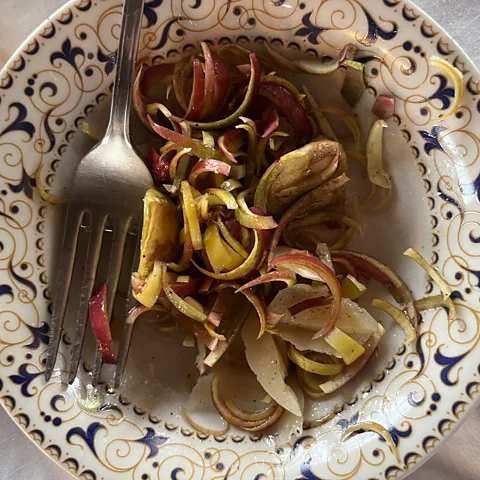The water glitters in the sunlight as Venetian farmer Guia Camerino steers her boat past the briccole, the wooden piles that mark invisible – to non-Venetians – lanes through the lagoon. Just a few kilometres north of Venice’s warren of tourist-packed streets are the islands of Sant’Erasmo and Le Vignole, known as “the vegetable garden of Venice” for their lush, fertile ground – and for a rare flower that grows for only 10 days a year.
Camerino is one of just four farmers on the island of Le Vignole, and she specialises in the carciofo violetto di Sant’Erasmo, a Venetian type of artichoke plant that produces a local delicacy known as a castraùra. The castraùre are the plant’s first buds: small, tight and conical artichokes that are “castrated” off the plant – giving them their name – in order to allow the botoli, larger buds (and the kind you’d probably find on your plate the rest of the year), to grow in their place.
Spring is a busy time of year for Camerino as the violet artichokes come into bloom and must be harvested during a short window of about two weeks, with each plant only producing one castraùra a year. The tiny artichokes, half the size of a human palm, are highly prized, both for their rarity and their unique, saline taste.
“It’s hard to describe the taste if you’ve never had it before,” she explains, as we walk through her artichoke fields, the belltowers of Venice visible on the horizon. “It’s initially bitter but transforms into sweetness in the mouth. It’s very versatile and easy to eat – not like a Roman artichoke that you have to peel and prepare laboriously. The castraùre are so tender that you can eat them raw.”
 Catherine Bennett
Catherine BennettThe castraùre’s rarity means that for years Venetian farmers have had to deal with counterfeit versions coming from elsewhere in Italy. The violet artichoke doesn’t just grow in the Veneto – this species of plant is also grown in Tuscany, Sardinia and Sicily. But any Venetian will tell you that a true Sant’Erasmo artichoke tastes nothing like its terraferma counterparts. That’s because the islands are positioned at the lagoon’s opening to the Adriatic, which makes the soil distinctively salty – a salinity that is tempered by rainwater. There’s even a festival dedicated to the artichoke (usually on the second Sunday in May) when people travel from all over the lagoon to Sant’Erasmo to eat artichoke dishes, drink artichoke-based spritzes or digestifs and buy entire pallets of the vegetable to take home before the season ends.
World’s Table
BBC.com’s World’s Table “smashes the kitchen ceiling” by changing the way the world thinks about food, through the past, present and future.
It’s not easy to coax the flower out of the plant. Everything is done by hand, with no pesticides, and in Venice there’s the ever-present danger of an acqua alta (seasonal flooding) that could drown the fields. An artichoke is a perennial plant that has to be cut back every summer in order to grow imperceptibly during the winter months. Now climate change is causing the season to arrive earlier and earlier.
“It’s very worrying,” says Camerino. “The plant needs nine months to slowly grow. Traditionally, the castraùre were harvested on 25 April, Saint Mark’s Day. But we harvested our first castraùra at the beginning of April this year. It’s getting hotter earlier and earlier, and the plants won’t have time to grow. Eventually, the castraùre could disappear.”